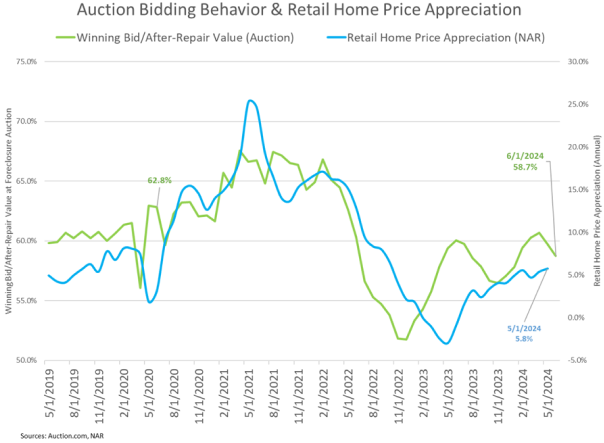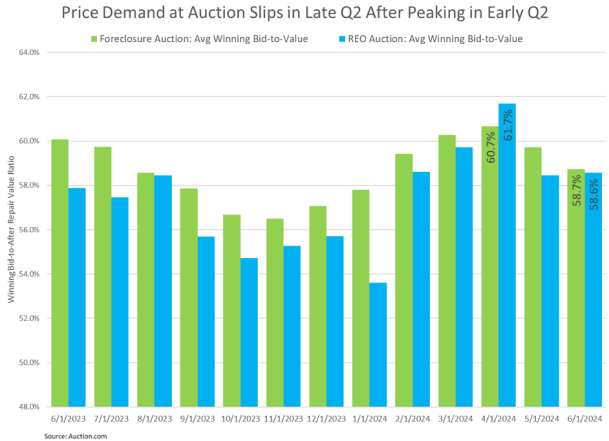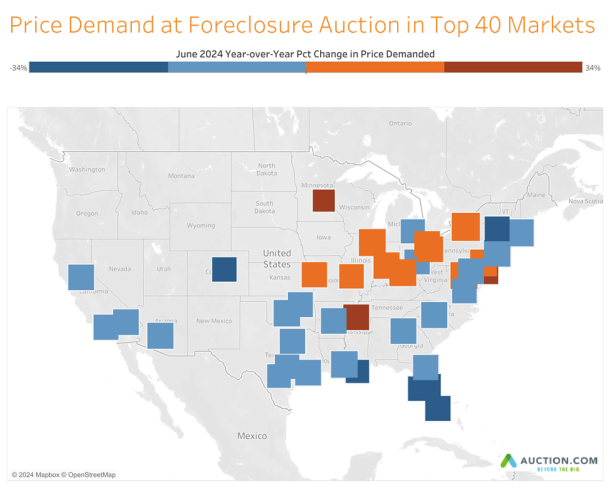Q2 Auction Demand Slips as Retail Inventory Rises
Sales rates and winning bid-to-value ratios pulled back in June even with
lower supply at auction.
July 26, 2024
KEY POINTS
- Overall strong demand for distressed properties at auction in Q2 2024 is undermined by early signs of slipping demand in June
- Average price-to-value ratio that bidders are willing to pay at auction drops in May and June after hitting 25-month high in April
- Some of the biggest drops in price-to-value ratios in markets with substantial increases in retail housing inventory
- Bid-ask spread at auction widens in May and June as sellers hold pricing steady even as bidders adjust pricing lower
OVERVIEW
After a strong showing in the first quarter of 2024 — and well into the second quarter — demand for distressed properties sold at auction showed early signs of slipping in June even as the supply of properties available at auction continued to contract, according to proprietary data from Auction.com, the nation’s largest distressed property marketplace that accounts for nearly half of all properties sold at foreclosure auction nationwide.
Although one month’s data is not yet a trend, the demand slippage in June could be an early indication that local community developers buying at auction are becoming increasingly wary of rising retail inventory, which represents competition for the renovated homes they sell or rent back into the retail market — typically within six months of buying at auction.
“I do feel like the retail market has softened,” said Tony Tritt, a local community developer operating in Northwest Georgia who renovates and resells properties he purchases at foreclosure auction, mostly to owner-occupant buyers. “I would expect a longer time horizon to get (my renovated properties) sold because they aren’t flying off the shelves like they used to.”
If it continues past June, the demand slippage from buyers like Tritt could also foreshadow a slowdown in retail home price appreciation. Because buyers at distressed market auctions are anticipating retail market conditions three to six months into the future, bidding behavior at those auctions provides a reliable forward-looking indicator of trends in retail home price appreciation.

DISTRESSED DEMAND
Demand Slips from Multi-Year Highs in Late Q2
Thanks to strong performances in April and May, most demand metrics at auction show strengthening demand for the second quarter overall compared to the previous quarter, but monthly data reveals a clear downshift in June for many demand metrics, including bidders per property, sales rates, and winning bid-to-value ratios.
The average number of bidders for each property sold at bank-owned (REO) auction in the second quarter was down 2 percent from the previous quarter but still up 3 percent from a year ago. But in June that bidders-per-property metric dropped 17 percent from May and was down 3 percent on a year-over-year basis.
The sales rate at foreclosure auction (the share of properties available at auction that sold) increased in the second quarter, both on a quarterly basis (up 5 percent) and annual basis (up 4 percent) but decreased 4 percent in June from a 25-month high in May. The June sales rate was still up 3 percent from a year ago.
A similar pattern of June demand slipping from a nearly two-year high earlier in the quarter shows up in demand metrics related to pricing — both for foreclosure auctions and REO auctions.
Winning bidders at foreclosure auction in June were willing to pay 58.7 percent of a property’s estimated after-repair value on average, down from a 25-month high of 60.7 percent in April. Winning bidders at REO auction in June were willing to pay 58.6 percent of a property’s estimated after-repair value on average, down from a 25-month high of 61.7 percent in April.

The declines in price demanded by auction buyers in June were still in the context of rising overall price demanded for the second quarter. The average winning bid-to-value ratio at REO auction for the entire quarter was up 4 percent from the previous quarter and up 1 percent from a year ago, while the average winning bid-to-value ratio at foreclosure auction for the entire quarter was up 1 percent from the previous quarter and also up 1 percent from a year ago.
Price Demand by Market
Several major markets where rising retail inventory is reaching dubious milestones saw a more prominent decline in the price demanded by distressed property auction buyers in June.
The winning bid-to-value ratio at foreclosure auction decreased by double-digit percentages from both the previous month and a year ago in Miami, New Orleans, Tampa Bay, Orlando and Denver. Retail inventory in May 2024 had risen above May 2019 levels in four out of five of those metro areas, with Miami being the one exception, according to data compiled by ResiClub. Miami, for its part, had the highest share of “stale” listings — the share of unsold listings sitting on the market for at least 30 days — of any major market in the country in May, according to Redfin .

DISTRESSED SUPPLY
Continued Contraction in Supply
The early signs of downshifting demand at distressed property auctions in June came despite a continued contraction in the supply of properties available to buy at auction in the second quarter.
The number of properties brought to foreclosure auction in the second quarter was less than half (46 percent) of the pre-pandemic level in Q1 2020. That was down from 49 percent in the previous quarter and down from 57 percent in the second quarter of 2023.
Supply of REO auctions was even more restricted relative to the pre-pandemic level in the second quarter. The number of properties brought to REO auction during the quarter stood at 36 percent of the Q1 2020 level, down from 38 percent in the previous quarter and down from 40 percent in the second quarter of 2023.
Supply by State
Supply did continue to vary widely by state. States with the most supply of properties brought to foreclosure auction relative to pre-pandemic levels in the second quarter of 2024 were Connecticut (319 percent of Q1 2020 level), Alaska (139 percent), Kentucky (122 percent), Louisiana (120 percent), South Dakota (113 percent) and Colorado (103 percent).
States with the lowest supply of properties brought to foreclosure auction relative to pre-pandemic levels in the second quarter of 2024 were Florida (22 percent of Q1 2020 level), Rhode Island (22 percent), Nebraska (23 percent), Virginia (25 percent), and Georgia (26 percent).

DISTRESSED PRICING
Bid-Ask Spread Widens in June
The bid-ask spread between what bidders were willing to pay and what sellers were willing to take for distressed properties at auction stayed relatively flat in the second quarter overall compared to the previous quarter and a year ago, but the bid-ask spread widened noticeably in June as the price demanded by buyers downshifted without a corresponding downshift in pricing by sellers.
For the entire second quarter, the bid-ask spread for foreclosure auctions was 4 percentage points, up slightly from 3 points in both the previous quarter and a year ago, while the bid-ask spread for REO auctions was 10 percentage points, unchanged from the previous quarter and down slightly from 11 points a year ago.
But in June, the bid-ask spread for foreclosure auctions was 6 percentage points, up from 3 points in April and May to a 16-month high, and the bid-ask spread for REO auctions was 11 percentage points, up from a 25-month low of 8 points in April.

The widening bid-ask spread in June was not as much the result of increased pricing by sellers — primarily banks, nonbanks, mortgage servicers and government-sponsored entities. In fact, sellers as a group kept pricing relatively steady between the beginning of the quarter in April to the end of the quarter in June. During that period, seller pricing was virtually unchanged for properties brought to REO auction and up 1 percent for properties brought to foreclosure auction.
Instead, the widening bid-ask spread was mostly the result of the more dramatic downshift in price demanded by buyers between the beginning of the quarter in April and the end of the quarter in June. During that period, pricing demanded by buyers was down 3 percent at foreclosure auction and down 5 percent at REO auction.
MACROECONOMIC TRENDS
Rate
Probability
Index
Sentiment Index
HOUSING & MORTGAGE TRENDS
Home Sales
Prices
Mortgage
Mortgage Rate
